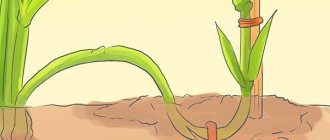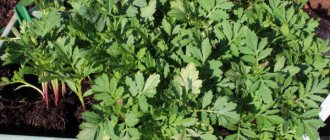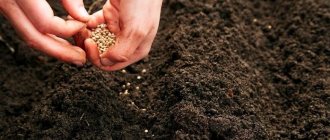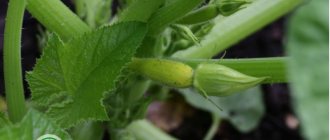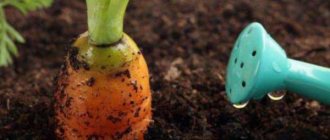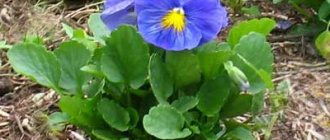There is no such gardener and gardener who would not plant beets. One of the most common vegetable crops, it is easy to grow and has a long shelf life. Indispensable in borscht, vinaigrettes and beetroot soups. Its history dates back to the times of Kievan Rus.
Today we will talk about how to plant and grow beets in open ground, as well as when and how to sow in order to get a good harvest. Consider planting seeds in open ground and seedlings. I will say right away that growing beets is a completely simple task that anyone, even a novice gardener, can cope with.
In the meantime, while you haven’t planted it yet, I recommend growing and harvesting radishes and treating yourself to a wonderful okroshka.
After what crops can beets be planted?
Every year, beets should be planted in open ground in spring in different areas . You can return to your previous landing site after no less than four years. This is due to reasons such as:
- soil depletion;
- breeding of pests;
- development of diseases.
Beets like to grow after nightshades : potatoes, tomatoes, eggplants. It is also useful to plant it after plants rich in essential oils: garlic and onions.
It is good to plant beets after cucumbers, squash, and zucchini . The roots of these plants grow on the surface, so the necessary nutrients for beet growth remain in the soil.
What to plant after beets and what to combine planting with
When observing crop rotation, it is important to remember that you should not plant crops from the same family in one place . After harvesting, plan to plant garlic, eggplants, cucumbers, pumpkin or carrots in this place next year.
To save space in your garden, interplant . Plant parsley, onions, spinach, lettuce, and dill between the rows of beets.
Preparing beet seeds for sowing
Beet seeds can be processed or unprocessed.
If you come across seeds in such a colored shell, then such seeds do not need pre-planting treatment.
They have already been processed in advance, disinfected and have stimulants in the shell for better germination.
If the seeds are not treated, they can first be soaked for 10 minutes in a weak solution of potassium permanganate or Fitosporin.
If desired, beet seeds can be germinated in advance. To do this, place them between wet wipes or in wet sawdust and in a greenhouse.
The beets will germinate and sprout much faster after planting, which means you will get the harvest a little earlier.
In addition, it will be clearly visible which seeds did not germinate and which should not be planted.
Important: this technique is recommended for planting in well-warmed soil!
If you plant sprouted seeds in cold soil, then at best they can slow down their development, and at worst they will simply rot.
Therefore, only in warm weather.
Variety selection
Table beets are grown in vegetable gardens , which are used to make borscht, vinaigrette, and salads.
Varieties differ in terms of ripening:
- Early ripening - from 50 to 80 days.
- Mid-season varieties - from 80 to 100 days.
- Late ripening - longer than three months (such root vegetables are stored longer and have a rich taste).
When choosing a variety, it is necessary to take into account that the sizes and shapes of root crops differ from each other.:
- spherical;
- cylindrical;
- elongated;
- flattened.
Advice. Choose varieties bred in your area for planting in your garden.
When to plant a vegetable
Planting seeds on time is the key to a bountiful harvest . Beets do not like the cold; they are planted when the earth is already warm.
Calendar dates
Sowing beets in open ground in spring begins when the daytime air temperature reaches 16°C . The vegetable is planted after planting the carrots; the time for sowing the seeds is before May 15. In warmer regions, planting begins at the end of April. If spring is delayed, planting dates are postponed a week later. The main thing is that the weather is warm.
Planting according to the lunar calendar
The lunar calendar will help you calculate the correct days when to plant beets in the spring and carry out timely planting . It has been used since ancient times, calculating the time of planting crops depending on the phase of the moon. Our ancestors noticed that when it grows, the above-ground part of the plant actively develops, and when it decreases, the root system grows. The calendar is calculated annually.
Different ways to plant beets
Proper planting of beets will completely determine its further growth and obtaining a high-quality harvest.
Preparing and planting beets with seeds
To check the quality of seeds before planting, you should germinate them. It's quite easy to do this:
- You need to take a flat saucer or plate;
- Lay out a damp felt or canvas rag, always with a double layer;
- Place 50 or 100 beet seeds on top;
- Cover with the same damp cloth.
After some time, the seeds begin to germinate. It is necessary to calculate how many seeds have sprouted from those planted. Thus, it is much easier to calculate how much harvest the purchased batch will produce.
Watch the video! Pre-sowing preparation of beet seeds and planting them in open ground
Important! You need to understand that in this way you can only check a batch of seeds that has been pre-sorted.
Beet seeds have practically no differences, so you can sort out the spoiled ones quite easily. Beets last a long time, and it has practically been proven that more than 80% of the seeds have a good chance of germinating. The shelf life of beets in the seed state can vary from 3 to 5 years.
Any good gardener has an idea of how to speed up the process of crop growth. In the case of beets, you can use already proven methods. The most common and easiest way is to soak beet seeds in water without additives. The water needs to be changed every 2 – 3 hours.
Advice! The water temperature must be carefully monitored; only warm water can create good conditions for seed germination.
Planting germinated seeds in the ground
Planting seeds after germination does not require special knowledge and skills; the most important thing for all novice gardeners is to observe the depth at which the beets will be planted. This crop should not be sown too deep, as the germination process will be more difficult. In addition, at great depths there will be insufficient oxygen for the seeds, which creates the risk of losing part of the crop.
You need to find the optimal depth, since you can’t plant a crop completely on the surface; the seeds will be exposed to the wind and scattered throughout the garden.
The distance between rows must be maintained. The minimum distance is 20 cm, and you should take into account what type of beet is being planted. But in any case, you will have to thin out the vegetable, since it is usually sown more densely than other types of crops. Fertilizing the beds before directly planting the seeds is also welcome, but only in small quantities.
Planting beets for seedlings
For lovers of year-round harvesting of beets, there is the possibility of getting the harvest earlier than usual. To enjoy this crop already in May, you can create suitable conditions for growth for the vegetable crop. A greenhouse or insulated ridge will be one of the best options. The most important thing is to care for seedlings more actively in cold weather.
Growing and care
Planting and caring for crops in open ground in spring requires the following measures::
- Seed preparation. For germination, the seed is soaked for three days in a water solution, adding 1 tsp. soda per 0.5 l.
- Landing in the ground. Before sowing the seeds, the prepared wells are watered with a hot 1% solution of potassium permanganate.
- Seeds are sown in holes at a distance of 3-5 cm from each other.
- During planting, nitrogen fertilizers are applied: 1 tbsp. l. ammonium nitrate per 1 m of bed.
- The soil is loosened throughout the entire period of crop growth.
- When the seedlings grow to 7 cm, they are thinned out, leaving 10 cm between plants.
- The soil between the rows is mulched with straw and mown grass.
It will be interesting:
Top 12 best beet varieties: review and selection tips
Rules for obtaining a rich beet harvest
Step-by-step guide on how to thin beets correctly
Soil preparation
Preparing the soil for planting begins in the fall or early spring. Choose illuminated places where there is no groundwater.
The remaining vegetation is removed from the garden and the soil is dug up. If the soil is too acidic, add lime by spreading it in a thin layer before digging.
When preparing to grow beets, pay attention to the condition of the soil. Beets do not like clay soils. Acceptable soil is loamy, sandy loam, black soil.
Measures to improve the soil in the garden:
- If the site has acidic soil, wild sorrel, rapeseed, and horsetail grow, lime should be added.
- Clay soils require the addition of sand.
Seed preparation and planting procedure
Seed preparation will help avoid diseases and grow crops without loss. Let's consider what activities should be carried out :
- Hardening . The seeds are placed in the freezer for 30 minutes.
- Disinfection . The seeds are poured with a light pink solution of potassium permanganate and kept for two hours. Then the water is drained and the seed is dried.
- Soaking . The seed is placed in a deep plate, filled with water so that it covers the seeds, and placed in a dark place for three days.
The autumn harvest depends on the correct planting of beets in the spring.
Planted in two ways:
- Seeds . Make holes 3 cm deep in the ground and fill them with water. When it is absorbed, place the seeds at a distance of 3-5 cm from each other. Cover with soil, compacting the top layer of soil.
- Seedlings . Seeds are sown in a greenhouse, planted four per hole. When four leaves grow, they are transplanted into the ground. Before planting, seedlings are hardened off by regularly ventilating the greenhouse.
Advice. When thinning beets, the ones that are pulled out can be used as planting material. She is accepted and grows.
How to grow beets. And a little about dill.
Thinning of seedlings
When planted densely, plants grow poorly, the stems weaken and become elongated.
To form a bed, two thinnings are carried out:
- When the second leaf appears . The seedlings are thinned out, removing excess ones. The distance between plants is maintained at 7 cm.
- In three weeks . Leave a distance between plants of 15-20 cm.
Important! Before thinning, the bed must be watered so as not to damage the roots of the plants when pulled out.
Care
Care includes fertilizing, watering, loosening and mulching.
Feed twice a season:
- When the seedlings grow four leaves . Seedlings are fertilized after rooting. Urea is added at the rate of 10 g per 1 sq. m.
- A month later . During this period, plants need potassium-phosphorus fertilizers. 1 tbsp. l. superphosphate and potassium chloride are diluted in a bucket of water. Fertilizers are designed for 1 square. m. landing.
Attention! Fertilizers must be applied after watering.
What to do about the following problems:
- The core of the root crop rots - there is not enough boron or copper. In this case, foliar fertilizing is done with boric acid (1 tablespoon per 1 liter of warm water).
- Yellow spots appeared on the tops - a lack of potassium. Deoxidize the soil by adding lime milk (dilute a glass of lime in 10 liters of water, add 1 tablespoon of potassium chloride). The solution is enough for 10 linear meters. m beds.
- Beet tops turn red from a lack of sodium - sprinkle the bed with ash or water with salt water (a glass of salt per bucket of water).
Beets love moisture, so they need careful watering.
Watering rules:
- shower the plants from above;
- pour thoroughly so that the water penetrates deep into the roots;
- after watering, loosen the soil;
- do not allow the soil to dry out.
To enrich plants with oxygen, the soil should be loosened after each watering . In order not to damage the root crops, loosening is carried out between the rows.
Mulching will help retain moisture in the soil . To do this, use straw and hay, laying mulch in a 3 cm layer in rows.
Pests and diseases
There are more than 30 pests that most often attack young seedlings . The most common of them:
- Beet aphids spread on leaves.
- Root aphid : affected plants turn yellow, wither, the roots become covered with a white coating, and the plants are easily pulled out.
- Beet flea beetle attacks young seedlings. If you don't react in time, it can destroy the entire plantation.
- The weevil overwinters in the soil and attacks the first shoots.
- The leafminer fly lays eggs in early spring. The hatched larvae penetrate deep into the stem, feeding on the tissue. Such plants die quickly.
- Beet nematode is a small thread-like worm that penetrates the root and disrupts its structure. The roots branch excessively and the vegetables lose weight.
Beets are susceptible to the following diseases:
- Corn beetle - microorganisms that damage beet seedlings. The shoot stem becomes constricted and the root dies.
- Cercospora blight is a fungus that multiplies in leaf tissue and grows into a mycelium. Over time, many spots form on the leaves, the plant withers and disappears.
- Downy mildew is a fungal disease that affects leaves. The color changes, the leaves grow poorly and die over time. Root crops affected by the disease quickly disappear.
- Fomoz appears due to a lack of boron. In young plants, the disease affects the roots, they rot and dry out. On adult plants, Phoma appears as light brown spots. Such root vegetables rot quickly.
- Rogue rot is a type of fungal disease. Affected fruits are dark in color and cannot be stored.
Planting seeds in open ground in spring
Traditional landing
After preparing the soil and forming the bed, make transverse furrows 4 cm deep on it. Determine at what distance to plant the rows of beets based on the variety and growing purposes. If you plan to grow small fruits for pickling, 10-15 cm will be enough. If you want beets for winter storage, measure 20-35 cm.
Water the furrows with water and after it is absorbed, plant the seeds at a distance of 5-6 cm from each other. Sprinkle with a layer of soil 2 cm high.
Planting in a narrow bed
The optimal width of a narrow bed for beets is 45-50 cm. In this case, the furrows are made not across, but along – two at the edges. With this planting, the plant receives enough sunlight - unlike a regular garden bed, where the middle rows remain dark and produce fewer fruits.
Another plus is that it is convenient to loosen the soil between the furrows with any garden tools.
Planting in a warm bed
A warm bed is formed on a layer of organic matter, which nourishes and warms the earth. Beets grow faster in such beds and are less sick.
There are two ways to arrange a warm bed:
- dig a trench for the nutrient layer;
- build a wooden frame and fill it with organic matter and soil.
In both cases, thick branches and pieces of boards are laid out at the base, and grass and leaves are placed on them. It is important that this is waste from plants that are not affected by diseases or pests. After laying the organic layer, it needs to be watered and covered with soil. A warm bed is used for 5-6 years in a row. Do not plant beets on it for the first two years - the vegetable will accumulate nitrates.
Mixed plantings
In mixed plantings, the soil is less depleted and weeds grow less frequently. Of course, if you maintain cultural compatibility. Don't forget that beets need a lot of space due to their vigorous foliage.
Features of planting and care depending on the region
The timing of planting and methods of caring for beets depend on the region where the vegetable is grown.
Features of crop care in warm regions:
- Planting begins at the end of April, the harvest is harvested in August.
- In hot weather, water twice a week.
- To preserve moisture, mulch the ground.
- In black soil conditions, fertilizers are applied twice per season.
In cold regions:
- The vegetable is planted in May and harvested in September-October.
- Watering is carried out if necessary.
- The soil does not need to be mulched.
- Due to the cold, wet weather, fungal diseases are prevented. Plants are sprayed with preparations containing copper.
The best conditions for beet growth
Beetroot is called a long-day plant.
The main secret to growing a rich beetroot harvest is providing the necessary conditions. This vegetable cannot be called too demanding of the environment, but you should not neglect the recommendations described below.
| № | Condition | detailed information |
| 1 | The soil | Fertile, loose soil is suitable for growing sugar beets. You can sow the seeds of the fruit in medium-loamy chernozem or peat bog. In this case, the soil should not be too acidic or alkaline. Such an environment leads to the fact that the vegetable quickly becomes unsuitable for further storage and consumption. |
| 2 | Humidity | The plant must be watered regularly, but overwatering is strictly contraindicated. Therefore, watering should be reasonable and not too frequent. At the same time, excessive dryness of the soil should not be allowed. If this happens, the shelf life of the root crop will be significantly reduced. |
| 3 | Temperature | For intensive vegetable growth, medium temperatures are required. The best condition is at least 8-10 degrees. |
| 4 | Lighting | Beetroot is called a long-day plant. Therefore, it needs to be provided with good and long-lasting lighting - at least 10-12 hours. For this reason, it should be planted only in areas of open ground that receive sufficient sunlight. |
The soil should be fertilized before sowing. It must be enriched with substances necessary for the growth of this root crop. Therefore, shortly before gardening, it is recommended to add compost or mineral fertilizer to the ground where the beet grains will be placed.
If the plant is provided with the proper conditions, the first shoots can be observed within 8 days. This is only possible if the ambient temperature does not fall below 5 degrees. At higher temperatures, the germination process will take 3-5 days.
General growing rules
It is not difficult to grow beets and get a good harvest. We present to you a few simple rules of care :
- Prepare the beds in the fall. Dig up and add 1 sq. m: 10 kg of rotted manure, 30 g of potassium chloride and superphosphate.
- Thin out plantings.
- Keep the beds clean.
- Do not allow the soil to dry out.
- Timely combat pests and diseases.
How to properly care for and water seedlings
In the first month after planting, special attention should be paid to watering.
Young sprouts need plenty of moisture to grow. Therefore, the earth should not dry out. The frequency of watering depends on weather conditions and sun activity. The average frequency is 1-2 times a week.
The water must be settled, so it is worth preparing it in advance. Rain water is well suited; it does not contain lime and has a beneficial effect on the plant. It is recommended to water in the evening, after sunset.
Watering is carried out carefully at the root so that moisture does not get on the tops. Then you should definitely loosen the soil to enrich it with oxygen.
To retain moisture, create a mulch layer. Sawdust or straw are suitable for these purposes. This is very important in dry summers, or when it is not possible to water frequently.
The frequency of watering is gradually reduced. And 14-20 days before harvesting, it should be stopped completely.
This tasty beauty is unpretentious in care. It takes very little effort to get a rich harvest.
The first shoots appear depending on the conditions of planting the seeds: if they were germinated in advance, then after 3-4 days; if the seeds hit the ground dry, then after a week. The time of emergence of seedlings also depends on such factors as how warm the earth is and how timely watering is carried out. If these factors are unfavorable, the seeds may take 10 to 14 days to germinate.
In order for air to penetrate to the root system, be sure to loosen the soil. In the future, this procedure should be carried out after each watering.
Due to the fact that several sprouts can appear from one seed, beets must be thinned. Moreover, this must be done several times during the summer season. This procedure is performed immediately after watering. The first thinning is done when the seedlings reach 7 cm, by which time they have up to 4 leaves. It is necessary to remove densely planted plants so that the distance between them becomes about 4-5 cm.
The second thinning is carried out at the moment when the root crop begins to form. During this period, the distance between them should be at least 10 cm. Also pay attention to unhealthy plants, they should also be removed.
Timely application of fertilizers is of considerable importance. This will affect the growth and formation of the vegetable. As a rule, over the entire summer season, fertilizing occurs in 2 stages.
The first is carried out immediately after thinning. Compost fertilizers, which must first be diluted in water, are very suitable. At the moment of root crop formation, preference should be given to fertilizers that contain potassium and phosphorus elements.


